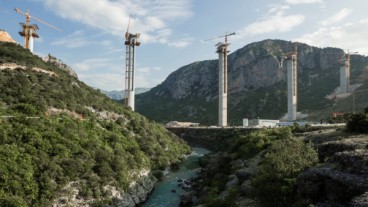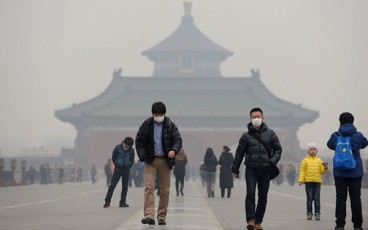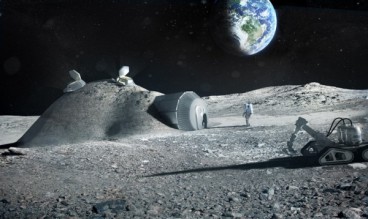China's Belt and Road Initiative is probably ‘the riskiest environmental venture in history’, researcher warns

Such an initiative can generate enormous economic benefits, but if not planned carefully, it can have unintended, negative environmental consequences
Such an initiative can generate enormous economic benefits, but if not planned carefully, it can have unintended, negative environmental consequences
The Belt and Road Initiative (BRI), previously called One Belt and One Road Initiative (OBOR), is an ambitious development strategy proposed by the Chinese Government in order to construct a unified large market between Eurasian countries, connecting them via the land-based Silk Road Economic Belt (SREB) and the aquatic Maritime Silk Road (MSR). Some estimates list the Chinese initiative as one of the largest infrastructure and investment projects in history, spanning more than 68 countries, including 65% of the world's population and 40% of the global GDP as of 2017, while critics call it a push by China to take a larger role in global affairs. But as the initial focus has been on infrastructure investment, there are more and more voices claiming China's plan to crisscross half of the Earth with massive transportation and energy projects is environmentally the riskiest venture ever undertaken.
Distinguished Professor William Laurance from James Cook University in Australia is one of them, saying that "China has enormous ambitions. But with that comes enormous responsibilities". “The government claims its Belt and Road will be a blueprint for responsible development, but that's going to require it to fundamentally change the way it does business internationally," he adds. Together with an international team of researchers from Australia, China, Germany, Portugal, Canada, and the U.S., he recently published an article in the Nature Sustainability journal, urging China to undertake rigorous strategic planning before embarking on its 'Belt and Road Initiative', which by mid-century, could involve 7,000 infrastructure projects and US $8 trillion in investment. Such an extended initiative could impact over 1,700 critical biodiversity areas and hundreds of threatened species, according to WWF .
"Too many Chinese firms and financiers operating overseas are poorly controlled by their government -- in large part because they are so profitable," Laurance said. "In the last two decades I've seen countless examples of aggressive and even predatory exploitation by Chinese firms, especially in developing nations with weak environmental controls and China is doing a much better job of improving environmental safeguards inside the country than internationally".
The authors say China has a unique opportunity to change its model of development and become a world-leader in sustainability. "It has produced a mountain of green documents and promises about the Belt and Road, but a leopard doesn't just change its spots overnight. China has a unique opportunity, but if it's 'business as usual' then I think the costs for the environment and economic risks for investors could be flat-out scary", Laurance concludes.
Source: James Cook University Australia News
Source: James Cook University Australia News
Media
Want to read more like this story?

China’s massive infrastructure boost to tackle coronavirus crisis
Mar, 01, 2020 | NewsThe government of China plans a series of new infrastructure projects to boost the economy after the...

Road collapses into a construction site in southern China
Jun, 19, 2019 | NewsOn June 8, 2019, a large part of a road suddenly collapsed into a building construction site in sou...

Flooding in China Causes Landslides and Leaves Over 170 Dead
Jul, 12, 2016 | NewsLast week, widespread flooding in the Yangtze river basin in China has left over 170 dead and millio...

China responsible for about 10% of global warming since the pre-industrial era
Mar, 27, 2016 | NewsThe flip side of an economic miracle The flip side of an economic miracle China is a country wit...

From Setback to Progress: The Future of UK Road Safety
Sep, 19, 2024 | NewsThe United Kingdom, once a global leader in road safety, has seen its progress stagnate over the pa...

Kenya's brand-new $1.5 billion railway project
Nov, 18, 2019 | NewsLast month Kenya opened a brand-new $1.5 billion railway line that links its capital city, Nairobi,...

Smart technology in road infrastructure
Nov, 25, 2019 | NewsA new project, currently conducted in the United Kingdom, aims to produce energy from traffic, compl...

Challenges for sustainable road networks in UK
Jan, 10, 2021 | NewsPreserving road networks is a challenging and abiding task that requires both short-term and lo...

China to construct a research base on the moon
May, 06, 2019 | NewsChina will attempt to build a research base in the south pole of the moon starting in the following...
Trending

Vertical gardens in Mexico City to combat pollution

Characteristics of Load Bearing Masonry Construction

Taipei 101’s impressive tuned mass damper

Saudi Park Closed After 360 Big Pendulum Ride Crashes to Ground, 23 injured

Dutch greenhouses have revolutionized modern farming

Federal court rules Biden’s offshore drilling ban unlawful


